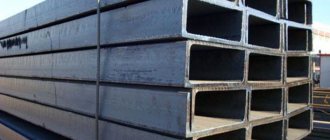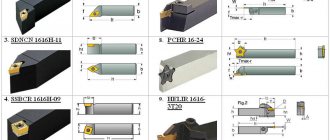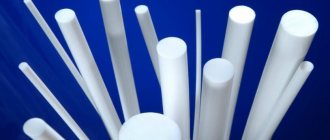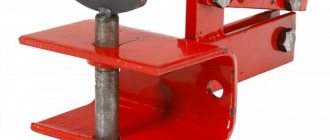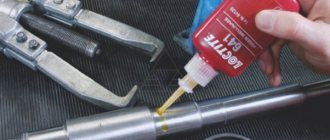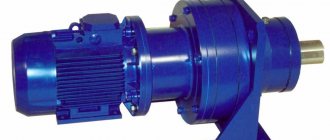Fluoroplastics or fluorolones are fluorine-containing polymers or plastics, which include fluoroplastics 2 (polyvinylidene fluoride), fluoroplastics 3 (polytrifluorochloroethylene), fluoroplastics-4 (polytetrafluoroethylene) and copolymers of ethylene fluorine derivatives.
The name “fluorlon” appeared in the Soviet Union, but did not take root. The material first came to the USSR during the Great Patriotic War from the USA: the Allies used it for seals and bearings for tanks . The first work on the creation of fluoroplastic began in 1947 under the leadership of Lev Vikentievich Chereshkevich. The first experimental batch was ready in 1949.
Ftoroplast-4
Most often, when fluoroplastics are mentioned, they mean fluoroplast-4. This is the most common and cheapest type of plastic to produce, known in Europe under several names. In the USA it is called “Teflon” or “Halon”, in the UK – “Flubon”, in Germany – “Gostaflon TF”, in Japan – “Polyflon”, in Italy – “Algoflon”, in France – “Soreflon” or “Gaflon” "
It is manufactured and sold both in “pure” form and with fillers: graphite, metal powders and fiberglass. Additives can enhance certain properties by tailoring the polymer to specific needs. Blanks are usually sold in the form of disks, rods, plates and pieces .
Fluoroplast-4 has excellent heat-resistant and anti-friction properties, is an excellent current insulator and can easily withstand even aggressive chemical environments. This allows the material to be used in the creation of the primary winding of high-voltage wires, conductive and heating cores, heating cables, in the manufacture of gaskets, washers, hoses for hydraulic systems and for heated floor equipment.
A little history
The discoverer of Teflon is the American scientist Roy Plunkett, who in 1938, while an employee of Kinetic Chemicals, witnessed the polymerization of gaseous tetrafluoroethylene and its transformation into a solid substance resembling paraffin. The resulting material exhibited properties that were amazing at that time, so it was immediately registered as a development by Kinetic Chemicals, which became part of the DuPont Corporation in 1949.
Teflon first came to the Soviet Union during the Second World War. The Teflon ring was part of the design of the turret rotation system for American-made tanks that came to the USSR under Lend-Lease. Soviet designers were impressed by the fact that a fluoroplastic gasket was used instead of lubricant to rotate the turret of a foreign tank. After reviewing the technical characteristics of the material, it was decided to set up our own production. For a long time, the use of fluoroplastic in industry, as well as the technology of its production in the Soviet Union, were classified.
Properties of fluoroplastic-4
The unique properties of a polymer are largely related to its molecular structure.
Due to the strong and stable bond between fluorine and carbon, the characteristics of fluoroplastic are not found in any other combination. This makes plastic a highly sought-after material. Materials with additions have been created based on fluoroplastic-4. Below are the data for the polymer fluoroplastic-4 .
- Density: 2.14-2.26 g/cm3.
- Melting point of crystals: +327С.
- Temperature range (minimum and maximum operating temperatures): from 260С to +260С.
- Decomposition temperature: above 415°C.
- Glass transition temperature of amorphous areas: 120С.
- Temperature of the highest crystallization rate: 310-315С.
- Wear rate: none.
- Friction coefficient for steel: 0.2.
- Thermal conductivity coefficient: 0.25 W/(m*K).
- Brinell hardness: 30-40 MPa.
- Water absorption: none.
- Breaking tensile stress: 20-30 MPa.
- Elongation at break: 250% to 500%.
Melting Features
- Fluoroplastic practically does not burn or melt, which allows it to be used in electronic equipment, radar stations and other sensitive devices. Combustion is possible only in the presence of oxygen; the amount of heat released is small - 10 times less than during the combustion of polyethylene.
Without an open flame, the combustion process is impossible: if you remove fluoroplastic-4 from the fire, it will stop burning . In this case, the process itself is not melting, but charring, but with strong heating (above 327Co), dangerous fluorine gases are released. The latter do not stand out in a vacuum. At a temperature of 415°C the material begins to decompose.
Material advantages
The popularity of fluoroplastic is explained by its unique properties. The material has a number of advantages, thanks to which it is successfully used both in mechanical engineering and in medicine. Its main advantages are:
- resistance to many aggressive chemicals;
- low coefficient of friction;
- large operating temperature range;
- low electrical conductivity;
- fire resistance;
- biological inertia;
- low surface tension.
Among other things, the material is easy to process; it can be drilled, grinded and milled without difficulty. Let us consider in more detail the scope of application of this polymer.
Areas of use
Due to the combination of unique properties and low price, fluoroplastic-4 is used in a wide variety of fields. Products may consist entirely of the substance, but in some cases only the surface is covered . They are easy to saw, drill, cut and do other work.
- In the electronics industry, fluoroplastic-4 is used for insulating wires, connectors, high-voltage cables and electrical machines, for the manufacture of printed circuit boards, cables and compressors.
- In the chemical industry, the material is used in the manufacture of hoses, pumps, storage and transportation containers, to protect various surfaces from corrosion. It is also used for storing alcohol, mixtures based on it and especially pure substances that should not be contaminated. Due to its high resistance, fluoroplastic-4 can be in contact for a long time with aggressive chemicals (acids and alkalis), oils, wastewater, salts, kerosene, oil and various types of fuel. The material is resistant to radiation, mold, fog and sun.
- In the food industry, the material is used as pumps, non-stick coatings, dough rollers, filters and seals for equipment.
- In medicine, fluoroplastic-4 is in great demand as containers for storing blood and medications, as a material for the manufacture of artificial blood vessels and valves. All products are hygienic and certified.
- In the mechanical engineering industry, the material is used in its “pure” form for bearings, gaskets, seals, cuffs, sliding bearings and piston rings - everything that lies in the friction areas of machines and devices. It is also suitable for work at high pressure, low temperatures and high vacuum.
Most often, impurities are added to the material to enhance hardness , wear resistance and other parameters. For example, adding graphite, bronze, fiberglass or coke can reduce wear and increase thermal conductivity and compressive strength.
Fluoroplastic: types, technical characteristics and application
Fluoroplastic is the general name for fluorinated plastics produced by the polymerization of tetrafluoroethylene. It is synthesized in the form of a white, easily clump-forming powder, and then pressed and sintered at high temperatures. It can contain from one to four fluorine atoms, which is reflected in the name of its types.
The most common fluoroplastic is polytetrafluoroethylene, known in Russia as fluoroplastic-4. In the USA it is sold under the brand names "Teflon" and "Halon", in Germany - "Gostaflon", in the UK - "Fluon", in France - "Gaflon" or "Soreflon".
Brands and technical characteristics of fluoroplastic
Currently, several brands of fluoroplastic are produced, differing in physical and chemical properties. Moreover, all of them are in demand in industry because they have unique technical characteristics:
- Resistant to almost any chemical attack.
- Low coefficient of friction.
- Resistant to adhesion to other surfaces.
- Heat resistance - the flexibility and elasticity of the material are maintained at temperatures ranging from -70° to +270°C.
- Minimum surface tension.
- Resistant to electric current and high temperatures. Fluoroplastic practically does not burn; it only chars in the flame, and when it is removed from an open fire, the charring completely stops.
- Stability in the food environment.
- The ability of fluoroplastic products not to change their length even under the influence of temperature.
Fluoroplastic is easy to process; it can be drilled, ground, milled and turned.
Note: Fluoroplastic was discovered in 1938 in the USA by chemist Roy Plunkett.
A patent for its production under the brand name “Teflon” was received in 1941. In the USSR, they learned about the new material during the war, having discovered parts made of fluoroplastic in American military equipment. However, Soviet scientists had to develop their own production technology, since the Americans kept theirs a closely guarded secret. There are four main grades of fluoroplastic, depending on the size of the molecules and their number in the chain. The higher this indicator, the greater the specific gravity of the substance.
- F-2 or polyvinylene fluoride (TU 6-05-646-77). It can also be produced with the addition of a modifier - cobalt, fiberglass, coke. In this case, the letter “M” is added to the marking. It is characterized by high strength, elasticity, and does not contain plasticizers, stabilizers or catalysts. Due to this, it is used in pipeline systems and the production of containers for aggressive liquids. F-2 is easily processed and is able to dissolve in aprotic (neutral) solvents.
- F-3 or polytrifluorochlorideethylene (GOST 13744-76). A variation is a modified version of the F-3M (TU 6-05-1812-77). A hard and durable material that can melt, soften and change shape during pressing and pouring. Resistant to low temperatures. It has good adhesion to metals and is used in anti-corrosion coatings.
- F-4 or polytetrafluoroethylene (GOST 10007-80). Refractory material with the highest density among all fluoroplastic materials. It has low porosity, high hydrophobicity, and temperature resistance. Able to withstand heating up to 260°C without changing properties.
Today, several varieties of F-4 are produced:
- F-4PN - used for the manufacture of products of increased reliability. Depending on the average particle size, it may have additional markings: F-4 (100–180 µm), F-4PN-90 (46–135 µm), F-4PN-40 (21–45 µm), F-4PN-20 (6–20 µm).
- F-4O - used for the manufacture of general purpose products (bushings, gaskets, parts of pipelines and pumps).
- F-4D is a finely dispersed modification with a lower molecular weight. Unlike F-4, it can be processed using extrusion and suspensions can be prepared from it. Used for the manufacture of films, coatings, fibers.
- F-4A is a free-flowing fluoroplastic. It has all the properties of F-4, but is more technologically advanced. It is used to produce products of precise size using automatic, isostatic, compression pressing and piston extrusion methods.
- F-4HTD is a finely dispersed fluoroplastic with a particle size of 5–30 microns. It is used as a dry lubricant in friction units of various mechanisms, a thickener for oils and greases.
The marking of fluoroplastic F-4 also contains the letter “M”, which means its modification with the help of various additives. Fluoroplastics of all brands find their application in industry.
- F-40. This is a copolymer of tetrafluoroethylene and ethylene (OST 6-05-402-47). It can be produced in two types: F-40P - for the manufacture of products under pressure by pressing and casting;
- F-40Sh - for the manufacture of products by extrusion.
The chemical properties of F-40 are close to those of fluoroplastic F-4 (see table). It is resistant to concentrated acids and solvents, does not burn, and does not transmit ultraviolet rays.
Table 1. Main technical characteristics of various fluoroplastic materials
| Name | Density, kg/m3 | Operating temperature, °C | Specific resistance, Ohm*m | Breaking stress (tensile), MPa |
| F-2 | 1780 | -45/ +150 | 1010–1013 | 44–55 |
| F-3 | 2090–2160 | -195/ +190 | 1015–1017 | 35–43 |
| F-4 | 2150–2240 | -260/ +160 | 1017–1018 | 16–35 |
| F-40 | 1700 | -200/ +200 | 1016 | 27–50 |
Areas of application of fluoroplastic
PTFE-4 is the most in demand in industry. To non-specialists it is known as Teflon. This is the same material that is used in the production of non-stick cookware. However, its use is not limited to this area. Fluoroplastic materials are indispensable in a variety of industries.
- Mechanical engineering . Due to its resistance to friction, bearings, oil seals, anthers, piston rings and even car tires are made from it and compositions based on it. PTFE parts ensure stable operation in aggressive environments, vacuum and at ultra-low temperatures. In addition, due to its unique heat resistance, fluoroplastic is quite suitable for the manufacture of engine parts.
- Light industry . Treatment with fluoroplastic can increase the water resistance of products, for example, shoes. Almost all clothing for sports and outdoor activities has a thin Teflon coating.
- Medicine . Since fluoroplastic does not cause immunological reactions and is biologically and physiologically harmless, it can be used to make prosthetic blood vessels, heart valves, blood and serum storage containers, and medication packaging. Fluoroplastic is also used in dentistry.
- Radio engineering and electrical engineering . Fluoroplastic is used as an insulator or current conductor, as well as for the manufacture of switches, relay elements, cables, and printed circuit boards.
- Chemical industry . Due to its exceptional inertness towards all acids and alkalis, fluoroplastic is used in the manufacture of laboratory glassware for various purposes, for transporting and storing chemically aggressive media in pipelines, in column-type devices, as gaskets in contact with aggressive media and for lining reactors.
- Food industry . For the manufacture of non-stick coatings for frying pans and pots, baking dishes, dough rolling mechanisms, storage containers.
Fluoroplastic can be produced in several forms - sheet, in the form of rods, tubes or bushings.
Types of polymer blanks
There are two types of fluoroplastic products - blanks and finished products. The first group is practically semi-finished products used in further technological processes. Blanks are manufactured in accordance with the requirements of TU 6-05-810-88 according to the approved technical regulations of the manufacturer. The dimensions of the workpieces must correspond either to the nomenclature list of the manufacturer or to the specifications agreed upon between the manufacturer and the customer. Maximum deviations from nominal dimensions are regulated by the requirements of OST 6-05-322-74, excluding sheets and rods pressed horizontally. Depending on the quality indicators, blanks can be produced in two grades - highest and first.
- Sheets and plates . They have a rectangular or square shape, sizes from 100x100 mm or 1000x1000 mm. The thickness of fluoroplastic sheets is from 1 to 60 mm. When manufacturing parts, sheets are machined.
- Films . Used for the manufacture of capacitors, insulation of wires, cables, production of seals for liners, bearings, filters, membranes. Film thickness can be from 10 to 100 microns, width - up to 300 mm.
- Rods and discs . The diameter of fluoroplastic rods is from 10 to 300 mm, height is from 50 to 2000 mm. Billets with a round cross-section are used for the manufacture of sealing, anti-friction and electrical insulating parts for various technological equipment. There are also rods with rectangular and square cross-sections.
- PTFE-4 bars
- Chips or powder.
Note According to data published in the scientific and technical publication “Bulletin of NTU “KhPI” (2013, No. 59 (1032)), the leadership in the production of fluoroplastic belongs to the United States, Western Europe is in second place, and China is in third place.
The second group is finished products. These include discs, tubes, tapes, bundles, and balls. They are completely ready for use as components for various mechanisms, equipment, and fittings. They can be produced both according to standard sizes and according to customer drawings.
Blanks and products are made from secondary fluoroplastic or compositions according to TU 6-05-1947-83 or from fluoroplastic powders thermally treated according to TU 301-05-25-89 by pressing or extrusion followed by sintering in molds. Sintering can be carried out under pressure or in a free state. The warranty period for all products and workpieces is 5 years from the date of manufacture.
Material prices
The price formation for fluoroplastic is influenced by several general factors:
- manufacturer (domestic, foreign);
- batch volume (large wholesale, small wholesale, retail);
- brand.
The price of sheet fluoroplastic F-4 is indicated per 1 kg, depending on the thickness of the sheet it varies from approximately 400 to 700 rubles.
The cost of the film is also indicated per 1 kg and averages about 1,700 rubles. The price of fluoroplastic rods, disks and rods depends on the diameter and production method (pressed or recycled); you can buy them for about 400–700 rubles per kg.
Powdered fluoroplastic is practically not found on the open market; its price is about 1000–1100 rubles per kg.
Blanks made from other types of fluoroplastic are somewhat cheaper than those made from F-4. For example, one kilogram of F-3 can be purchased for about 500–700 rubles, and F-2 for about 500–550 rubles.
The cost of finished products depends not only on weight, but also on the complexity of the part itself. For example, the price of a protective ring made of fluoroplastic for a BelAZ truck is about 16.5 rubles per piece. Standard products have a lower cost than those manufactured according to specially developed drawings. In this case, the price can be set individually for each specific case.
Where can I buy fluoroplastic
When choosing a polymer supplier, you need to pay attention not only to the price level, but also to some other important points.
We asked representative Mikhail Barinov to tell us where you can buy fluoroplastic and how to choose the right supplier: “You can purchase fluoroplastic of domestic or foreign production either directly from manufacturers or through numerous intermediaries. Some of them are distributors of one or another concern and are focused on monobrands. There are also large suppliers that have partnerships with several key manufacturers at once, which gives the buyer the opportunity to choose. MetPromStar is one of such suppliers, but at the same time it pursues a flexible pricing and marketing policy, without neglecting the interests of small wholesale customers who purchase products in small quantities.
We provide related services, such as cutting polymers and plastics exactly to customer dimensions using imported equipment and strictly according to technical specifications. Moreover, the qualifications of our employees, the technical equipment of the workshop and the quality control system allow us to produce finished products according to customer drawings, for example, bushings and simple parts for mechanical engineering. Before being sent to the client, purchased products are carefully and carefully packed in polyethylene in accordance with GOST standards to ensure tightness and protect them from possible exposure to the external environment.
Now the company’s operating rules are such that, having our own fleet of vehicles, in Moscow we deliver free of charge and quickly shipments from 400 thousand rubles within the 3rd transport ring, for the regions we provide free delivery to any transport company. Shipping terminals are located in almost all major cities of the country, including the cities of Siberia and the Far East.
We work only by bank transfer and on the terms of 100% prepayment. It is possible to temporarily store the purchased fluoroplastic in our warehouse if you decide to do pickup, but are not able to pick up the goods in a timely manner.
Competent MetPromStar consultants are ready at any time to provide qualified assistance in choosing a material or its standard size, and in order calculation.”
PS In addition to fluoroplastic, it sells granulated polyamide, blanks and products from block polyamide-6, caprolon according to TU 2224-001-78534599-2006 and TU 2224-036-00203803-2012, as well as rods and plates from polyacetal POM-S, vinyl plastic , polyurethane, textolite and plexiglass.
Safety precautions when processing fluoroplastic-4MB
Studies of the thermal destruction of F-4MB at a temperature range of 300-350oC using the vapor-phase analysis method, carried out at ONPO "Plastpolymer", showed that the main components of destruction released in the specified temperature range are the original monomers TFE and HFP. Other components, including perfluorocyclobutane, are released in small quantities and after 30 min of heating the sample, they practically cease to be released.
In accordance with the legislation in force in Russia, workers and engineers working with fluoropolymer melts are entitled to a reduced working day and additional annual paid leave.
The safety data sheet for chemical products for fluoroplastic-4MB according to GOST 30333-2007, made by fluoroplastic developers, can be requested through the feedback form.
Preparation method
All these varieties are obtained chemically. In essence, they are polymers to which fluorine atoms have been added. Hence their name.
Fluoroplast-4 is synthesized in the form of a white powder, and then pressed and sintered at high temperature. Other grades of this material are usually obtained by hardening.
PTFE is used in the manufacture of many innovative modern products. The technical specifications are truly amazing. The advantages of this material include:
- High chemical resistance. Fluoroplast-4 does not dissolve even when boiled in aqua regia.
- Inertness and low porosity.
- Very low coefficient of friction. This indicator for fluoroplastic remains practically unchanged at any temperature.
- Excellent dielectric properties. This material remains an insulator even at a temperature of 200 degrees.
- Stability. The chemical properties of fluoroplastic-4 do not change at temperatures up to -300 degrees.
- Fire resistance is another advantage of a material such as fluoroplastic. Its characteristics (the heat-resistant polymer is self-extinguishing) make it possible to use it in places with a high fire hazard.
- Gas tightness.
- Biological compatibility. This type of plastic is often used to make dentures.
Shapes and types of fluoroplastic blanks
Fluoroplastic is used to make either blanks (semi-finished products) or finished products. Blanks are produced in accordance with TU 6-05-810-88. There are two options for regulating the sizes of semi-finished products. Firstly, the nomenclature of the manufacturer. Secondly, the specifications agreed between the customer and the manufacturer.
Tolerances for nominal sizes are recorded in OST 6-05-322-74 (except for sheets and rods that are pressed in a horizontal position).
According to grade, billets are divided into two types - highest and 1st grade.
Semi-finished products from fluorlon are:
- shavings, powder;
- film;
- disk, rod, block;
- sheet or plate.
Fluoroplastic sheet
A fluoroplastic sheet (plate) is a rectangular polymer product. It can be either standard or foil, modified, reinforced. The quality of sheet manufacturing is determined according to GOST 6-05-810-88, GOST 21000-81.
For plates (sheets) made of F-4 (Teflon), use TU 6-05-810-88. The overall dimensions of the sheets are: length from 300 to 1000 mm, width from 300 to 1000 mm.
The thickness of fluoride sheets is from 2 to 20 mm. According to GOST 21000-81, foil-coated sheet fluoroplastic grades are produced:
- FF-4. Length, width from 100 to 400 mm, thickness - from 1.5 to 5.0 mm. Production technology: pressing with further sintering.
- FAF-4D. Overall dimensions: length from 280 to 500 mm, width from 170 to 500 mm, thickness - from 0.5 to 5.0 mm. Production technology: layer-by-layer pressing of varnished fabric.
The size range can be expanded according to customer requirements. The scope of use of fluoroplastic sheets of various brands covers:
- production of pipes, hoses of various thicknesses;
- production of films (capacitor, insulating);
- production of dishes and other items for the food industry;
- insulation of cable products;
- lining of pipes and pumps.
Fluoroplastic rod (circle)
The fluoroplastic rod has the shape of a white cylinder. This polymer product is used in its pure form or modified. Requirements for the manufacture of rods are determined according to GOST 6-05-810-88, also GOST 21000-81. Production technology: vertical or horizontal pressing.
The rods vary depending on the brand of polymer, the additives and fillers used, and the presence of reinforcement.
The scope of use of fluoroplastic rods of various brands covers:
- manufacturing of dishes and other items for the food industry;
- production of thick-walled pipe products.
Finished products last for at least twenty years, operate without lubrication, and do not conduct electricity.
The diameter of the rods is from 10 to 300 mm, the length is from 70 to 1000 mm. You can buy fluoroplastic rods:
- extrusion;
- pressed;
- secondary.
Ftoroplast-2 (PVDF, PVDF)
The use of “two” in industry stems from several parameters in which this type of fluoroplastic is superior to others:
- high hardness, strength and rigidity (at temperatures up to 120 °C);
- resistance to water, solvents, radiation of any kind;
- biological inertness - does not react with food and living organic material;
- practically non-flammable;
- chemically pure material (there are no impurities that appear during the production of fluoropolymers).
For fluoroplastic-2, the operating temperature is to = 150 °C; melting temperature of fluoroplastic-2 = 170 oC.
It is considered a universal material, used in all areas of activity, subject to limited heating.
Process of creating PVDF
As a result of laboratory research, several technological processes have been developed for the production of fluoroplastic-2. According to the criteria of profitability and yield of the finished product, three chains are used in industry, differing in initiators and cost/quality balance.
Properties of PVDF crystalline phases
Fluoroplastic-2 has four types of crystalline phases that can transform from one to another under external influences:
- α-phase. Formed from a melt without the use of pressure or from other varieties during annealing.
- β-phase. Formed from a melt under a pressure of 350 MPa. It is of particular interest, since in this phase the material exhibits piezo- and pyroelectric effects.
- γ phase. Formed from a superheated melt. Unstable. Under mechanical influence (deformation of the sample) it passes into the β-phase.
- δ-phase. Formed from the α phase when exposed to an electric field. By annealing a sample in the δ phase, subject to certain conditions, one can obtain any of the other three varieties.
Manufacturers and applications
Currently, fluoroplastic-2 is not produced in Russia. Leading foreign suppliers: Agru (Austria), FIP Spa (Italy), Georg Fischer (Switzerland), Simona (Germany), Glynwed Pipe SYSTEMS LTD.
Pipes and pipeline assemblies (taps, fittings) for pumping aggressive media or for the production of highly pure materials are made from fluoroplastic-2.
Sheet F-2 is used for lining containers and walls of premises.
Finished products made from fluoroplastic-2, as well as rods or sheets, are imported to Russia.
Current Western sanctions have recently reduced purchasing opportunities.
Ecology and health effects
All the most commonly used brands of fluoroplastic are completely safe for humans and other living organisms. In addition, the properties of flutopolymers are known to be excellent in compatibility with living tissues, including not giving immunological reactions in humans. Such characteristics of fluoroplastic paves the way for them as materials suitable for the manufacture of medical prostheses and implants.
Also, fluoroplastics, especially F-4, are actively used in dentistry, cardiovascular surgery and other areas of medicine. They are used to make artificial heart valves and blood vessels. More and more, polymer is replacing expensive titanium, which was previously used for the production of prosthetics in most cases. The applications of fluoroplastic in medicine are constantly expanding.
